
Here’s the thing: onboarding isn’t just paperwork and a tour of the coffee machine. It’s about setting new hires up for success and ensuring they feel valued and engaged. New hire onboarding survey questions are your secret weapon in this mission.
These questions aren’t just about ticking boxes; they’re a direct line to understanding their feedback and helping you identify hidden roadblocks. They ensure that your onboarding truly sets them up for success.
Curious about how it works?
Here’s a blog exploring different onboarding survey question types, the benefits they unlock, and a list of questions to craft your new hire onboarding surveys.
Let’s get started.
What Is an Onboarding Survey?
Watch: 6 Quick Tips to Create Awesome Employee Engagement Surveys
An onboarding survey is a tool used by organizations to gather feedback from new employees or customers about their initial experiences. This onboarding feedback survey helps improve the process, ensuring it meets participants’ needs and expectations.
For employees, onboarding surveys can include:
- Questions about the clarity of job roles
- The effectiveness of training programs
- The overall welcome experience
For customers, these surveys often address the ease of navigating products or services and the support provided during the initial phase.
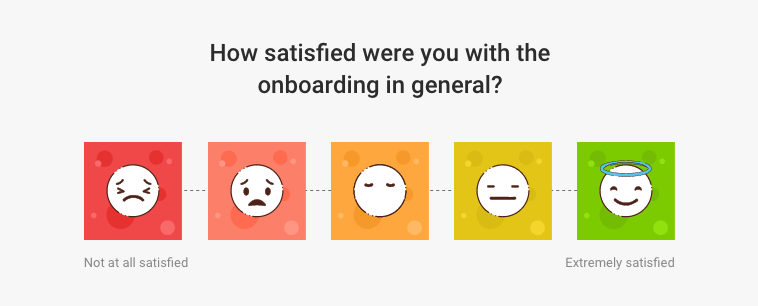
Studies show that effective onboarding can improve employee retention by 82% and productivity by over 70%. For example, LinkedIn found that new hires who underwent a structured onboarding program were 58% more likely to stay with the company for over three years.
By using onboarding surveys, companies can identify gaps, enhance their onboarding strategies, and ultimately foster a more engaged and satisfied workforce or customer base.
What Are the Types of Onboarding Survey Questions?
Onboarding survey questions can be categorized into the following different types:
1. Pre-Onboarding Questions
These onboarding survey questions for new hires are asked before the onboarding process begins to understand the expectations and prior experiences of the new employee or user.
Examples:
- What are your primary goals and expectations for this role/product?
- How did you hear about this job/product?
- What specific skills or features are you hoping to develop or use?
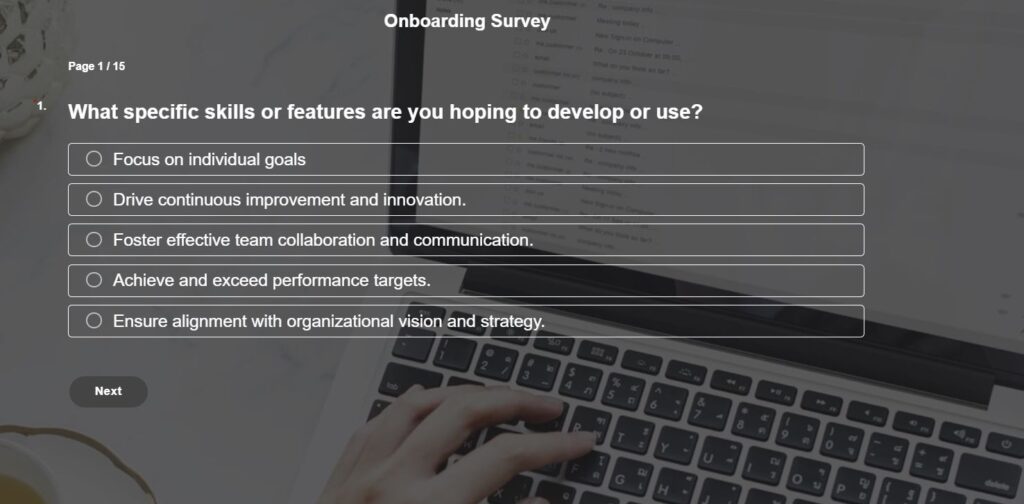
2. Welcome and First Impressions Questions
These employee questionnaires gauge the initial impressions and experiences of the new employee or user upon starting.
Examples:
- How would you rate your initial welcome experience?
- Were you provided with all the necessary information on your first day?
- How clear were the instructions for getting started?
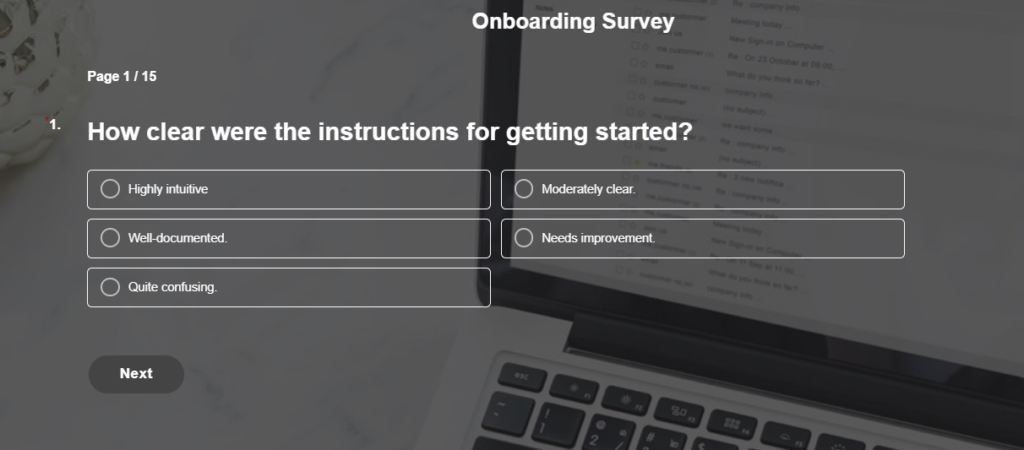
3. Training and Resources Questions
These new hire survey questions assess the effectiveness of the training and resources provided during onboarding.
Examples:
- How helpful was the training material provided?
- Were the training sessions engaging and informative?
- Did you have access to all the resources you needed to get started?
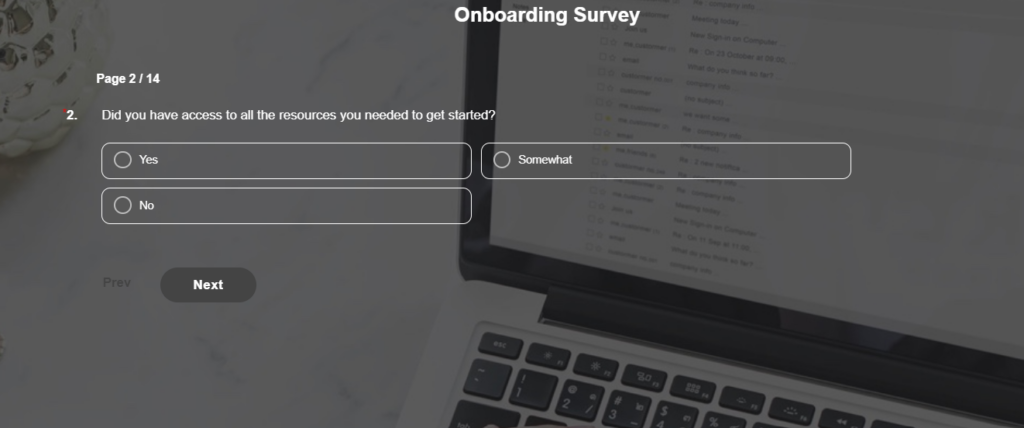
4. Support and Communication Questions
These questions focus on the level of support and quality of communication received during onboarding.
Examples:
- How responsive was your onboarding coordinator/mentor?
- Did you feel comfortable asking questions during the onboarding process?
- Was the communication clear and timely?
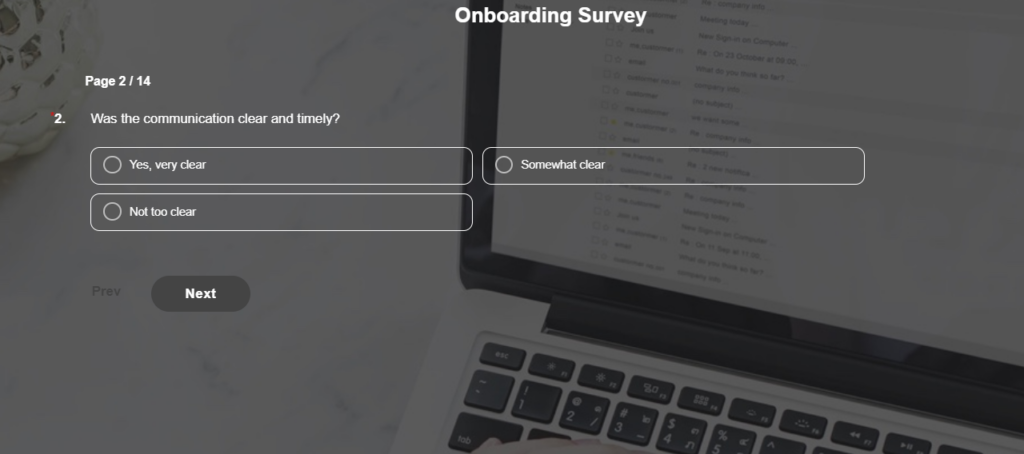
5. Role Clarity and Expectations Questions
These questions determine if the new employee or user has a clear understanding of their role and what is expected of them.
Examples:
- Do you have a clear understanding of your responsibilities?
- Are the expectations for your role/product usage clearly defined?
- How well do you understand the company’s goals and values?
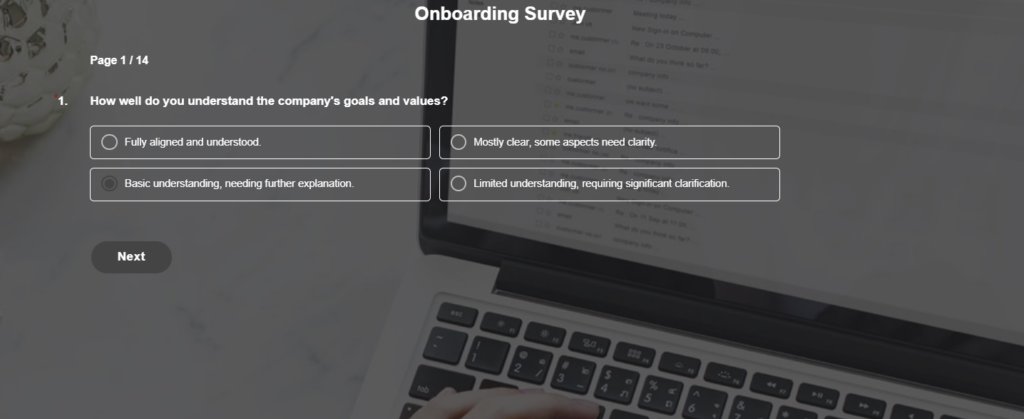
6. Integration and Team Dynamics Questions
These questions assess how well the new employee is integrating into the team and company culture.
Examples:
- How well do you feel you are integrating with your team?
- Do you feel included and valued by your colleagues?
- How would you describe the company’s culture?
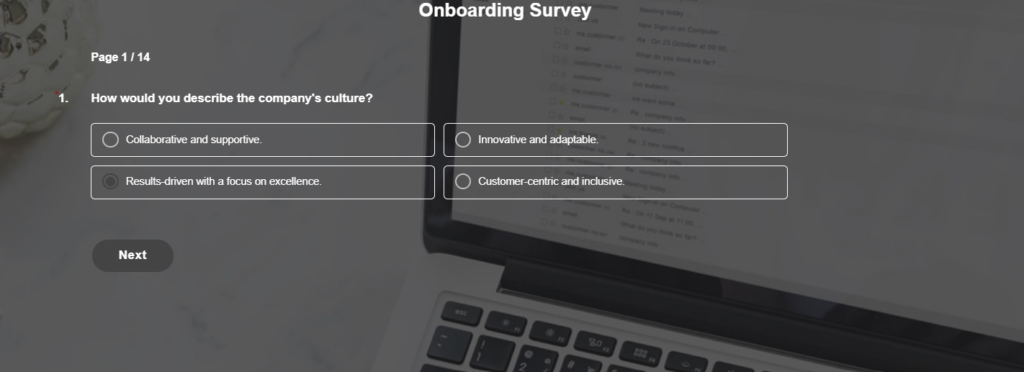
7. Feedback and Improvement Questions
These questions gather feedback on the overall onboarding experience and suggestions for improvement.
Examples:
- What areas of the onboarding process could be improved?
- Do you have any additional comments or suggestions?
- What did you like most about the onboarding process?
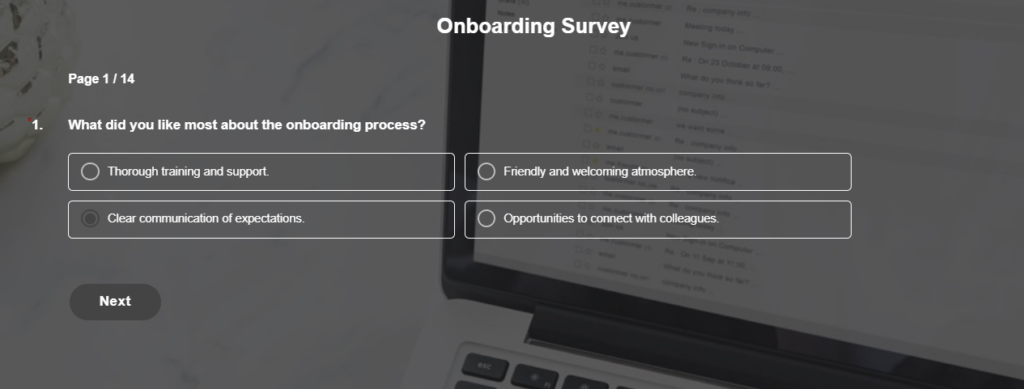
8. Post-Onboarding Experience Questions
These questions are asked after the onboarding process is complete to evaluate its long-term effectiveness.
Examples:
- How well prepared do you feel to perform your duties/product usage?
- Do you feel you have the necessary tools and knowledge to succeed?
- How would you rate your overall onboarding experience?
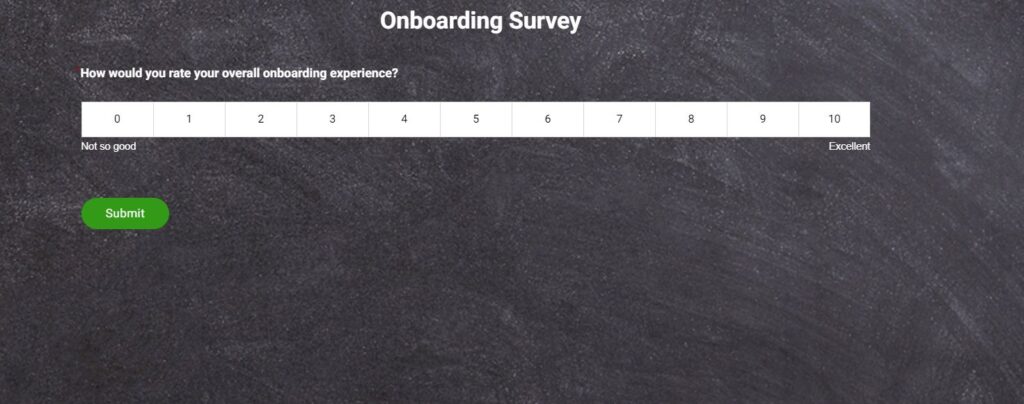
By covering these areas, organizations can ensure they capture comprehensive feedback to improve their onboarding processes continually.
Examples of Employee Onboarding Survey Questions
Here are some examples of employee onboarding survey questions grouped into various categories.
1. Pre-Arrival Experience
- How was your overall experience with our recruitment and hiring process?
- Please describe any difficulties you faced during the recruitment process.
- How clear were the instructions provided for your first day?
- Did you receive all the necessary information about your job role before your start date?
- How would you rate the communication from HR before your first day?
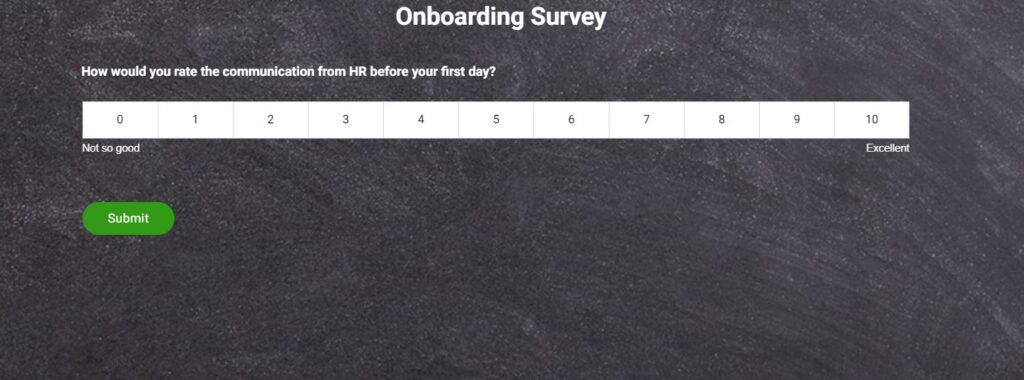
2. First Day Experience
- Can you describe your first day at work?
- What were the highlights of your first day?
- How welcoming did you find your new team on your first day?
- Did you feel prepared for your first day?
- How would you rate the orientation program provided on your first day?
- What could you have done to make your first day better?
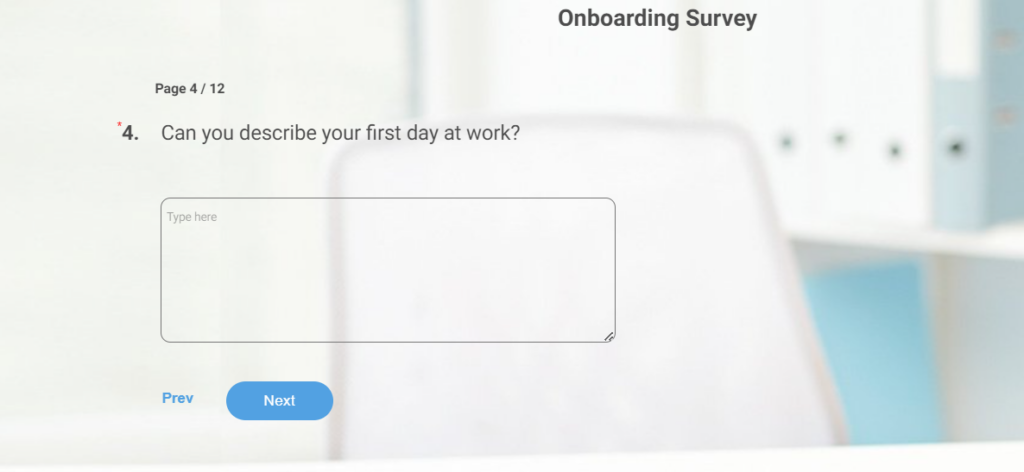
3. Training and Resources
- How would you describe the training you received in your first week?
- Were there any specific areas where you felt the training could be improved?
- How effective was the training in helping you understand your job role?
- Did you have access to all the necessary resources for your role?
- On a scale of 1-5, how would you rate the availability of training materials and resources?
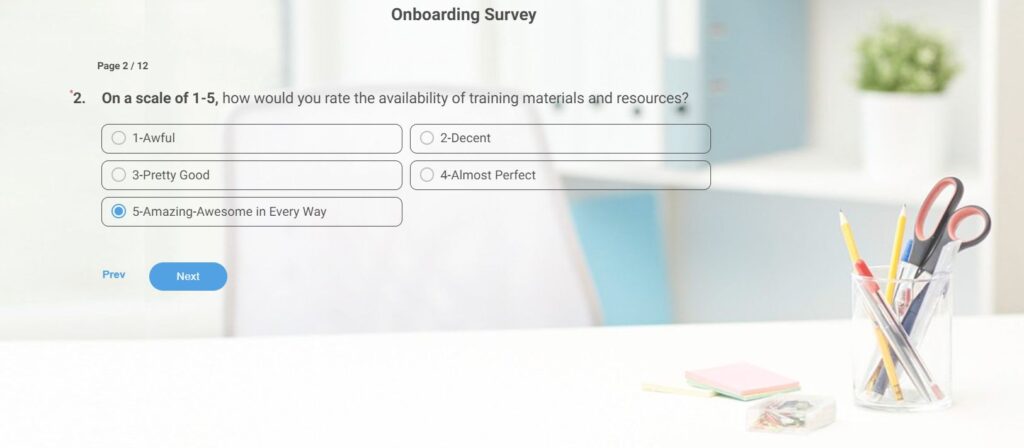
4. Integration with Team and Culture
- How well do you feel integrated with your team?
- Can you describe any challenges you faced while integrating with the team?
- How familiar are you with the company’s culture and values?
- Do you feel comfortable communicating with your team members?
- How supported do you feel by your team members?
- Do you have some suggestions for the team members?
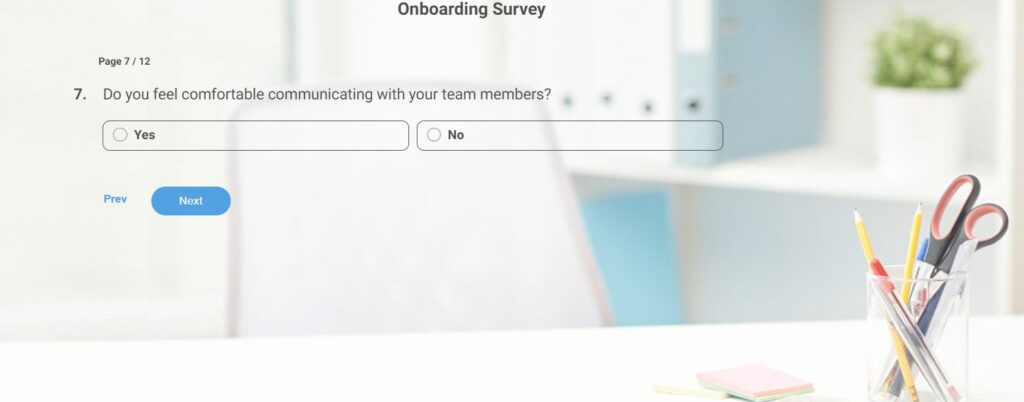
5. Overall Satisfaction and Feedback
- What aspects of your onboarding experience did you find most valuable?
- Are there any areas of the onboarding process that you believe need improvement?
- How satisfied are you with your overall onboarding experience?
- Would you recommend our onboarding process to future employees?
- How likely are you to provide positive feedback about the company based on your onboarding experience?
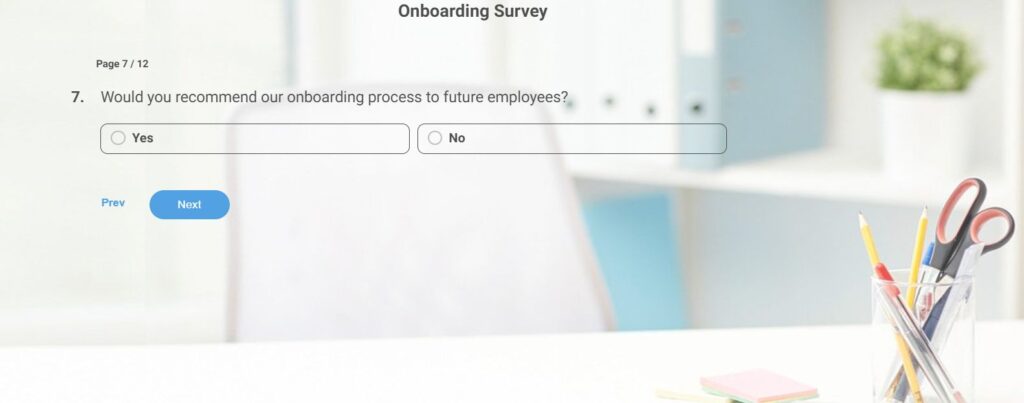
6. Role Clarity and Expectations
- How clearly do you understand your job responsibilities?
- What aspects of your role, if any, need further clarification?
- How aligned are your job expectations with the role you have started?
- Do you feel that your current role matches the job description provided?
- What additional information or training would help you better understand your role?

7. Workplace Environment
- How would you describe the physical work environment at our company?
- Are there any changes you would suggest to improve the workplace environment?
- How comfortable do you feel in your workspace?
- What aspects of the workplace environment do you find most conducive to productivity?
- Are there any environmental factors that hinder your ability to work effectively?

8. Support and Guidance
- How would you rate the support you have received from your HR so far?
- What additional support do you need to perform your job effectively?
- How accessible are the resources you need to do your job?
- How would you describe the availability of mentorship or guidance in the workplace?
- What suggestions do you have for improving the support and resources provided to new employees?
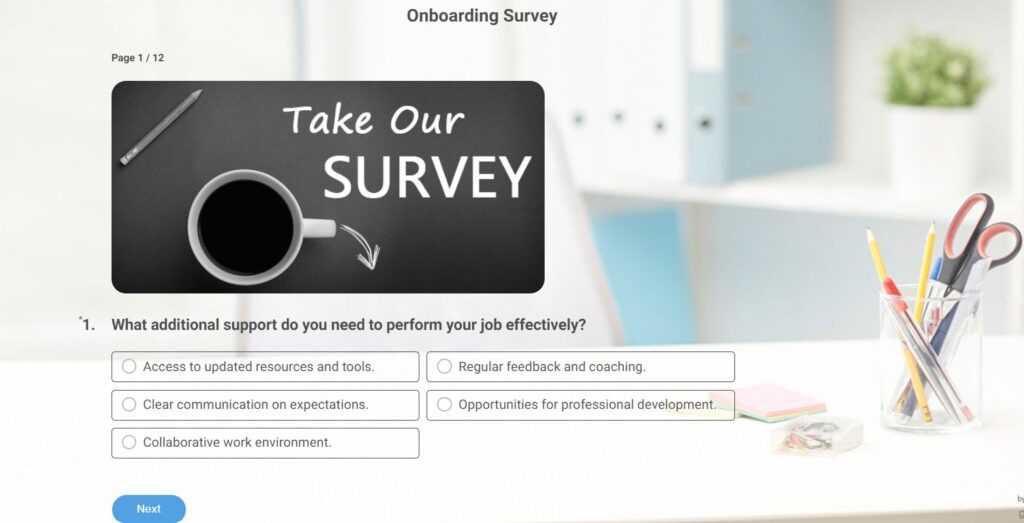
How to Implement Employee Onboarding Surveys?

Implementing employee onboarding surveys effectively can help gather valuable feedback from new hires, ensuring their integration into the company is smooth and successful.
Here’s a step-by-step guide to help you in the process:
1. Define Clear Objectives
Determine what you want to achieve with your onboarding survey. Are you looking to measure satisfaction, gather suggestions, or identify any issues in the onboarding process?
Pro Tip: Clearly communicate the purpose of the survey to new employees. When they understand the importance of their feedback, they are more likely to provide thoughtful and honest responses.
2. Design the Survey
Create a well-structured survey that includes a mix of question types (e.g., multiple-choice, open-ended, Likert scale) to gather both quantitative and qualitative data.
Pro Tip: Keep the survey concise and focused. Limit it to 10-15 questions to respect the employee’s time while still gathering comprehensive feedback.
3. Use Digital Tools
Utilize online survey tools that are user-friendly and easily accessible. These tools often come with templates that can be customized to fit your specific needs.
Pro Tip: Choose a survey tool that allows for anonymity. Anonymous responses can lead to more honest feedback, as employees feel safer sharing their true opinions.
4. Schedule the Survey
Send the survey at strategic points during the onboarding process, such as after the first week, first month, and at the end of the onboarding period.
Pro Tip: Automate the survey distribution. Set up automatic reminders to ensure employees complete the survey without manual follow-ups.
5. Analyze the Data
Collect and analyze the data systematically to identify trends, strengths, and areas for improvement in your onboarding process.
Pro Tip: Use data visualization tools to present findings clearly. Visual aids like graphs and charts can help stakeholders easily understand the results and make data-driven decisions.
6. Act on Feedback
Develop an action plan based on the survey results. Address the concerns raised and make necessary adjustments to the onboarding process.
Pro Tip: Communicate the changes made as a result of the feedback to the employees. This demonstrates that their opinions are valued and taken seriously, which can boost morale and engagement.
7. Continuous Improvement
Regularly update the survey to reflect any changes in the onboarding process or company policies. Continuously seek feedback from new hires to keep improving.
Pro Tip: Incorporate a follow-up survey to assess the long-term impact of the onboarding process. This can provide insights into the sustained effectiveness of the initial onboarding efforts.
By following these steps and integrating the pro tips, you can create an effective employee onboarding survey process that enhances the onboarding experience and supports continuous improvement within your organization.
What Are the Benefits of a Good Onboarding Survey?
Watch: Benefits of Using Online Surveys for Businesses
A good onboarding survey can significantly enhance the onboarding experience for new employees, offering a range of benefits for both the organization and the employees.
Here are some key benefits:
1. For the Organization
- Improved Retention Rates: By gathering feedback on the onboarding process, organizations can identify and address potential issues early, helping to retain new hires.
- Enhanced Employee Engagement: A well-designed onboarding survey shows that the organization values employee opinions, which can increase engagement and loyalty.
- Identification of Training Needs: Surveys can reveal areas where new hires feel underprepared, allowing for targeted training and support.
- Streamlined Onboarding Process: Feedback from surveys can help refine and improve the onboarding process, making it more efficient and effective over time.
- Cultural Alignment: Understanding how well new employees are integrating into the company culture can help HR make adjustments to support cultural alignment better.
- Performance Insights: Early feedback can provide insights into potential performance issues, allowing for timely interventions.
2. For the Employees
- Enhanced Experience: New hires feel heard and valued when they are asked for feedback, leading to a more positive onboarding experience.
- Better Role Clarity: Surveys can help identify areas where new employees need more information or clarification about their roles and responsibilities.
- Increased Confidence: Knowing that their feedback can lead to real improvements helps new employees feel more confident and comfortable in their new roles.
- Faster Integration: By addressing concerns and providing support based on survey feedback, new hires can integrate more quickly and effectively into the team.
- Support and Resources: Employees can express their needs for additional resources or support, ensuring they have what they need to succeed from the start.
What Are the Best Practices for Onboarding Surveys?

Some of the best practices to ensure effective outcomes out of the onboarding surveys are as follows:
1. Keep It Short and Simple
Surveys that are concise and straightforward are more likely to be completed. Long surveys can overwhelm users, leading to lower response rates. Focus on essential questions that provide valuable insights without overloading the respondent.
Pro Tip: Limit the survey to 5-10 questions to maximize completion rates. Use straightforward language to avoid confusion.
2. Use a Mix of Question Types
Incorporating various question types, such as multiple-choice, rating scales, and open-ended questions, helps gather comprehensive data. This approach balances quantitative and qualitative insights, offering a fuller picture of the user’s experience.
Pro Tip: Combine multiple-choice, rating scales, and open-ended questions to gather both quantitative and qualitative data. This provides a more comprehensive understanding of the user’s needs.
3. Personalize the Survey
Personalizing surveys by addressing users by their names and tailoring questions based on their previous interactions enhances engagement. Personalization makes the survey feel relevant, increasing the likelihood of thoughtful and accurate responses.
Pro Tip: Address the user by their name and tailor questions based on their previous interactions or known preferences. This makes the survey feel more relevant and engaging.
4. Ask Relevant Questions
Ensuring that all questions in the survey are directly related to the user’s experience and your objectives makes the data collected more useful. Irrelevant questions can frustrate users and dilute the quality of the feedback.
Example:
Irrelevant Question
Q: What is your favorite movie genre?
Relevant Question
What goals do you hope to achieve using our product/service?
Pro Tip: Focus on questions that will provide actionable insights to improve the user experience. Avoid asking for information you don’t plan to use.
5. Timing is Key
The timing of survey distribution affects response rates and accuracy. Sending surveys immediately after key interactions, like registration or first use, ensures that the experience is fresh in the user’s mind, leading to more precise feedback.
Pro Tip: Send the survey shortly after a key interaction, such as completing a registration process or using a product for the first time. This ensures the user’s experience is fresh in their mind.
6. Explain the Purpose
Clearly explaining the survey’s purpose and how the feedback will be used builds trust with users. When users understand the importance of their input, they are more likely to provide honest and thoughtful responses.
Pro Tip: Clearly state why you’re conducting the survey and how the feedback will be used. This builds trust and encourages honest responses.
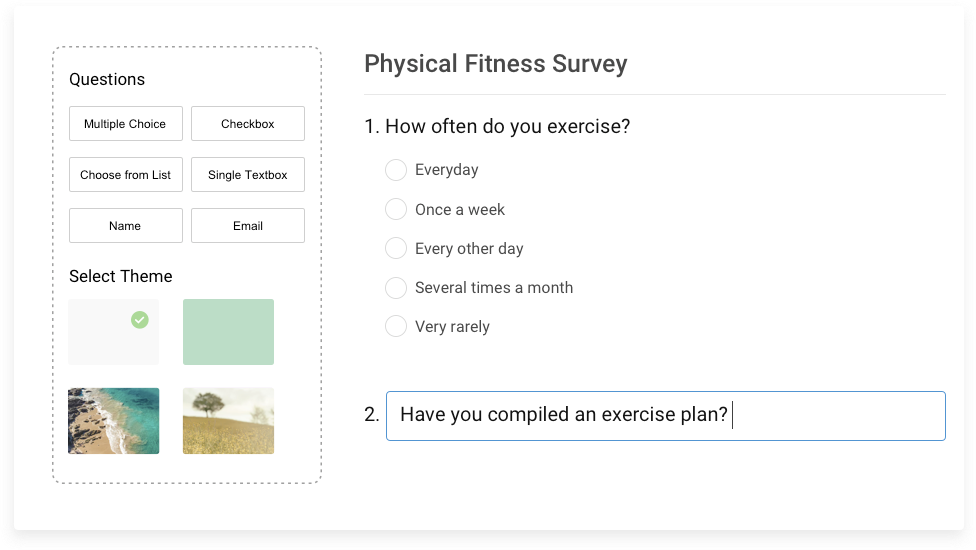
7. Offer Incentives
Providing incentives, such as discounts or prizes, can significantly boost survey participation rates. Incentives should be relevant and appealing to ensure they motivate users to complete the survey.
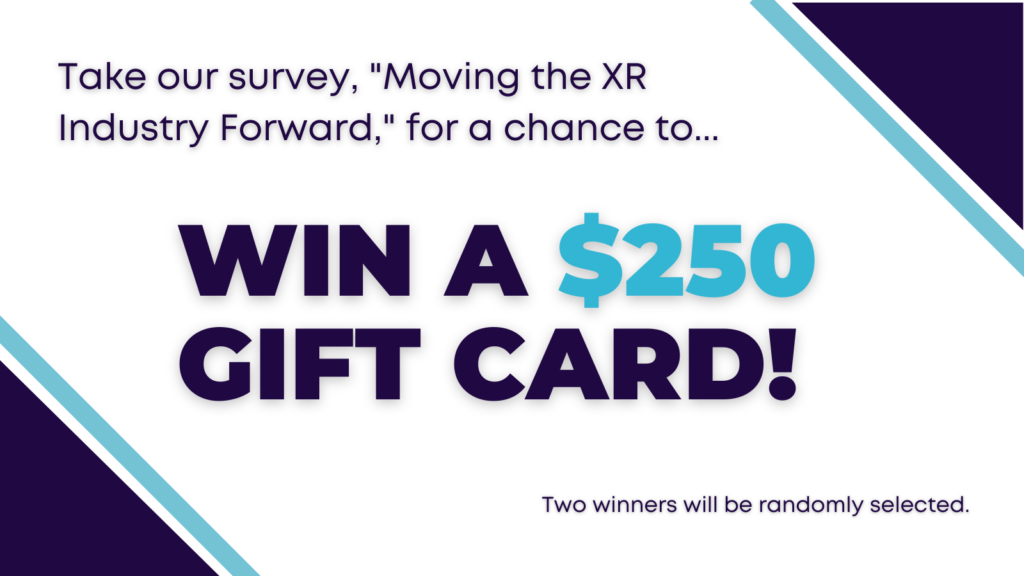
(Image Source: XR Association)
Pro Tip: Provide a small incentive, like a discount or a chance to win a prize, to increase participation rates. Make sure the incentive is relevant and appealing to your audience.
8. Follow Up
Following up with respondents by thanking them and sharing how their feedback is being used demonstrates appreciation and transparency. This can enhance user loyalty and show that their input has a tangible impact.
Pro Tip: Send a thank-you message after the survey and share how their feedback is being used. This shows that you value their input and are taking action.
9. Make It Accessible
Ensuring that surveys are accessible across all devices, especially mobile, increases the likelihood of completion. A mobile-friendly design allows users to provide feedback conveniently, regardless of their location or device.
Pro Tip: Ensure the survey is mobile-friendly and can be easily accessed from any device. This helps capture feedback from users on the go.
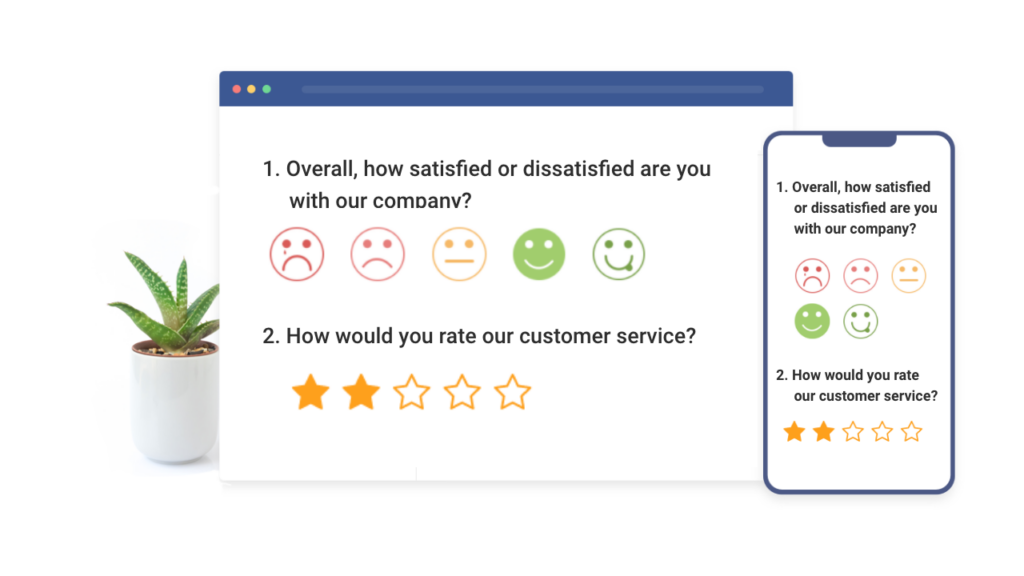
10. Analyze and Act on Feedback
Regularly analyzing survey responses to identify trends and actionable insights is crucial. Implementing changes based on feedback demonstrates that user opinions are valued and can lead to continuous improvement.
Pro Tip: Review the survey responses regularly to identify trends and areas for improvement. Based on the feedback, implement changes and communicate these improvements to your users.
Improve Retention Through Onboarding Survey Questions
Using the potential of onboarding survey questions, you can significantly enhance your onboarding process. These questions provide valuable insights, helping to tailor experiences that foster engagement and satisfaction.
By optimizing your onboarding surveys, you can identify strengths and areas for improvement, leading to higher retention and productivity. An effective survey tool is crucial in crafting the right questions and analyzing responses.
If you are looking for a good survey tool to create the most effective questions, I would suggest ProProfs Survey Maker. This online tool is one of the best options for creating onboarding survey questions due to its user-friendly interface, customizable templates, and powerful analytics. It also supports multiple question types and 70+ languages, which makes it effective for a diverse audience.
FREE. All Features. FOREVER!
Try our Forever FREE account with all premium features!









